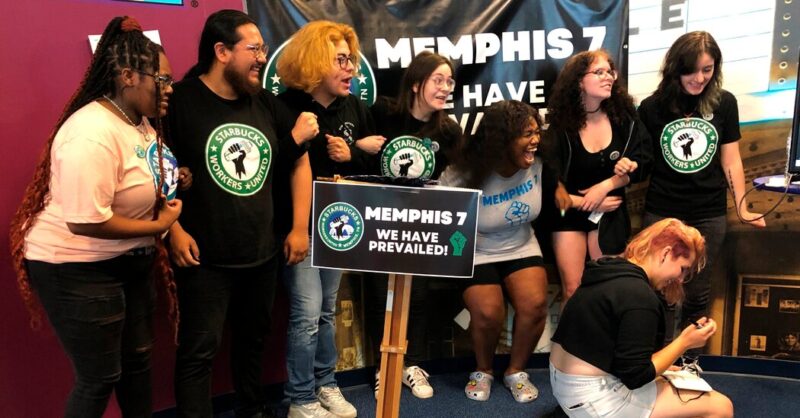The Supreme Court ruled in favor of Starbucks on Thursday in a challenge against a labor ruling by a federal judge, making it more difficult for a key federal agency to intervene when a company is accused of illegally suppressing labor organizing.
Eight justices backed the majority opinion, which was written by Justice Clarence Thomas. Justice Ketanji Brown Jackson wrote a separate opinion that concurred with the overall judgment but dissented on certain points.
The ruling came in a case brought by Starbucks over the firing of seven workers in Memphis who were trying to unionize a store in 2022. The company said it had fired them for allowing a television crew into a closed store. The workers, who called themselves the Memphis Seven, said that they were fired for their unionization efforts and that the company didn’t typically enforce the rules they were accused of violating.
After the firings, the National Labor Relations Board issued a complaint saying that Starbucks had acted because the workers had “joined or assisted the union and engaged in concerted activities, and to discourage employees from engaging in these activities.” Separately, lawyers for the board asked a federal judge in Tennessee for an injunction reinstating the workers, and the judge issued the order in August 2022.
The agency asks judges to reinstate workers in such cases because resolving the underlying legal issues can take years, during which time other workers may become discouraged from organizing even if the fired workers ultimately prevail.
In its petition to the Supreme Court, the company argued that federal courts had differing standards when deciding whether to grant injunctions that reinstate workers, which the N.L.R.B. has the authority to seek under the National Labor Relations Act.
Some apply a looser standard, requiring the labor board to show that there was “reasonable cause” to believe the company had violated labor law. Others use a stricter standard, requiring the board to show that not reinstating the workers would cause “irreparable harm,” and that the board was likely to prevail in the case. (Some courts combine elements of the two standards.)
Starbucks argued that the stricter standard for reinstating workers should apply nationwide. The labor board argued that the apparent differences between the two standards were semantic and that there was effectively one standard in place already, making it unnecessary for the Supreme Court to intervene.
The majority opinion rejected the board’s argument that the differences between the two standards were semantic. “The reasonable-cause standard goes far beyond simply fine-tuning the traditional criteria,” the majority wrote. “It substantively lowers the bar for securing a preliminary injunction.”
The opinion pointed out that in cases where other laws allow judges to issue preliminary injunctions, the stricter standard was typically applied. It concluded that nothing in the labor law suggested that courts should deviate from that approach when it comes to reinstating workers.
More than 400 Starbucks stores representing over 10,000 workers in the United States have unionized since 2021, and the two sides began holding nationwide talks on a contract framework in April. Starbucks owns and operates about 10,000 stores across the country.
During arguments in April, the court appeared likely to side with Starbucks, with conservative justices questioning why the N.L.R.B. needed a looser standard than other agencies for seeking an injunction.
The decision on Thursday returned the case to the lower courts.
Legal experts say the injunction is one of the N.L.R.B.’s most effective tools to stop companies from illegally suppressing union activity, by discouraging companies from firing workers who are trying to organize.
The N.L.R.B. requested fewer than 20 injunctions last year. But they serve as a powerful deterrent against firing workers trying to unionize, said Sharon Block, a professor at Harvard Law School and a former member of the N.L.R.B. With a stricter standard in place to win the reinstatement of fired workers, more companies may feel empowered to crack down on unionization efforts, Ms. Block said.
In her opinion, Justice Jackson agreed that the board should have to demonstrate irreparable harm if the workers were not reinstated, and that it was likely to prevail on the merits. But, she argued that these were relatively easy to show in cases in which the board sought injunctive relief.
She argued, for example, that irreparable harm was almost trivial to prove, because labor law violations typically take years to adjudicate. If a worker is fired and there is no possibility of a resolution for several years, she contended, this irreparably harms the board’s ability to remedy the situation — the relief will inevitably come too late.
Justice Jackson pointed to congressional language suggesting that other workers might become discouraged and abandon their organizing campaign even if the fired worker were eventually made whole.
But some see the agency as having used the injunction inappropriately in recent years, accusing the N.L.R.B. of taking on the role of an advocacy group. Don Schroeder, a partner with the law firm Foley & Lardner who is a labor and employment lawyer, said the agency had used the injunction too frequently over the past few years. He said it should be granted rarely.
“It gives a lot of leverage to the N.L.R.B. if the standard is very low,” Mr. Schroeder said. Granting an injunction is “not like spotting a unicorn,” he added. “But at the same time, it shouldn’t be an everyday occurrence.”
Starbucks expressed satisfaction with the Supreme Court decision. “Consistent federal standards are important in ensuring that employees know their rights and consistent labor practices are upheld no matter where in the country they work and live,” a company spokesman said.
He added that the company sought to reach ratified contracts at unionized stores this year.
Lynne Fox, president of Workers United, the union representing the Starbucks employees, said the decision was lamentable. “Working people have so few tools to protect and defend themselves when their employers break the law,” she said in a statement. “That makes today’s ruling by the Supreme Court particularly egregious.”
The N.L.R.B. didn’t comment on the ruling but pointed to an earlier comment from its general counsel, Jennifer Abruzzo. “Without obtaining this temporary relief, the lawbreaker will fully reap the benefits of having violated workers’ rights — such as by snuffing out a nascent organizing drive — through the passage of time,” Ms. Abruzzo said, “because a board remedy in due course will come too late to sufficiently address the harm.”
The Starbucks case (Starbucks Corporation v. McKinney, No. 23-367) was the latest in a series of challenges to the N.L.R.B.’s authority. In February, Amazon argued in a legal filing that the board itself was unconstitutional, after similar arguments from SpaceX and Trader Joe’s.
The Supreme Court ruling also marks the continuation of a larger movement on the political right to remove power from not just the N.L.R.B., but also federal agencies more broadly. In January, the justices appeared likely to overturn a key legal doctrine known as Chevron deference.
Legal experts say the overturning of that principle, which established that judges must defer to federal agencies when interpreting ambiguous laws passed by Congress, would hamper the government’s regulatory power over the environment, health care and more.
Combined with other cases before the court, “it’s another piece in the court undermining the expert status of administrative agencies,” Ms. Block said.

